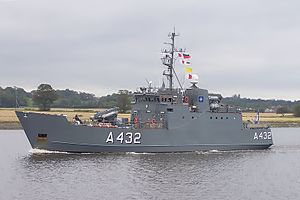
The Delfinen-class submarines were the first class of submarines constructed for the Royal Danish Navy following World War II. They were designed and built within Denmark, with first three boats of the class financed by Denmark. The fourth was financed by the United States under the Cost Share program. Constructed between 1956 and 1963, the class comprising four submarines entered service in 1961 and the last taken out of service in 1990. Replaced by the Norwegian Kobben class, three of them were scrapped while a fourth was converted into a museum ship and remains on display at the Aalborg Maritime Museum.

The Admiral Petre Bărbuneanu-class corvette is a series of four corvettes designed and constructed for the Romanian Naval Forces primarily for anti-submarine warfare. Only two corvettes out of a total of the four are still in service. Designed and constructed in the 1980s, they are a product of the Cold War with their armament and sensors based on Soviet designs. This class of corvettes was superseded by the Rear-Admiral Eustațiu Sebastian (Tetal-II) class.

The Le Redoutable-class submarine was a ballistic missile submarine class of the French Navy. In French, the type is called Sous-marin Nucléaire Lanceur d'Engins (SNLE), literally "Missile-launching nuclear submarine". When commissioned, they constituted the strategic part of the naval component of the French nuclear triad, then called Force de frappe.
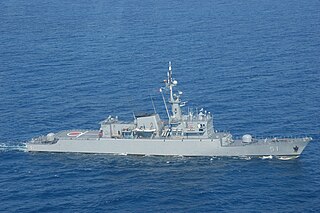
The Almirante Padilla-class frigates is a series of frigates operated by the Colombian Navy. The designation of this class is Type FS 1500 and there are four ships in service. The ships were built by Howaldtswerke-Deutsche Werft (HDW) at Kiel, West Germany in the 1980s, with the first vessel commissioning in 1983 and the last in 1984. The frigates have undergone significant modification over their careers with the 2012 Orion Program Upgrade significantly modernising the vessels. Two similar ships operate as the Kasturi-class corvettes in the Royal Malaysian Navy.

The Vidar-class minelayers consists of the two ships, HNoMS Vidar and HNoMS Vale built by Mjellem & Karlsen in Bergen for the Royal Norwegian Navy in 1977 and 1978. Used as multi-role ships, the Vidar class were tasked with minelaying, personnel/cargo transport, fisheries protection, torpedo-recovery ships and as anti-submarine warfare escorts in Norwegian service. In 2003, Vale was transferred to the Latvian Navy via donation and renamed Virsaitis and used as a flagship and tender to patrol craft. In 2006, Vidar was transferred to the Lithuanian Navy and renamed Jotvingis and served as flagship and tender to mine countermeasures craft. Both vessels had their ASW equipment removed upon transfer.

The Natsushio-class submarines were a pair of submarines constructed and operated by the Japan Maritime Self-Defense Force during the Cold War. They were a development of the Hayashio-class submarines and are sometimes considered the same class. They were small and limited in capability but were thought to be a successful class. They entered service in 1963–1964 and were deleted in 1978.
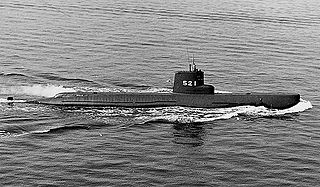
The Hayashio-class submarine was the successor design to the Japanese submarine Oyashio, and the predecessor of the Natsushio class with the Japan Maritime Self-Defense Force. Ordered in 1959, the boats were small with limited capability but were successful. Constructed in Japan from 1960 to 1962, they remained in service until 1979 when they were discarded.

The Kuha-class minesweepers is a series of six inshore minesweepers of the Finnish Navy. The ships were constructed in 1974–1975. All the vessels of the class were modified and modernized in the late 1990s, including a lengthening of the hull. Two of the class were withdrawn from service in 2012. The rest of the class will be retired with the entry into service of the Katanpää-class mine countermeasure vessels.

Godetia (A960) was a command and logistical support ship of the Belgian Naval Component, launched on 7 December 1965 at the Boelwerf in Temse and entered service on 2 June 1966. The patronage of Godetia was accepted by the city of Ostend. She was the first of two support ships acquired to replace World War II-era ships. Used primarily to provide logistic support to Belgium's fleet of minesweepers, Godetia has also seen service as a training ship, royal yacht and fisheries protection. The vessel has served with NATO's Standing NATO Mine Countermeasures Group 1 in the Baltic and North seas. In June 2021, Godetia was taken out of service.
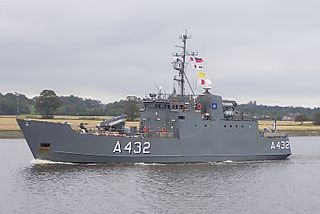
EML Tasuja (A432) was a Lindormen-class diving vessel built in 1977. She served in the Danish Navy as KDM Lindormen until 2004. Handed over to the Estonian Navy, she was commissioned as EML Tasuja in the Mineships Division until 2016.

The Poti class was the NATO reporting name for a group of anti-submarine warfare (ASW) corvettes built for the Soviet Navy. The Soviet designation was Project 204 small anti-submarine ships. These ships were the first Soviet warships powered by gas turbine engines; two propellers were mounted in tunnels to give a very shallow draught. A twin 57 mm (2 in) gun mounting provided self-defence. Three ships of the class were exported to Romania and six to Bulgaria during the Cold War. By 2008, all ships of the class were no longer extant.

The Ruotsinsalmi-class minelayers were a two-strong class of minelayers in the Finnish Navy. The two ships, comprising Ruotsinsalmi and Riilahti, were constructed in Finland and saw service in the Winter War and World War II. Riihahti was sunk in an engagement with Soviet motor torpedo boats on 23 August 1943. Ruotsinsalmi survived the wars and remained in service in the post war Finnish Navy until being withdrawn in the 1970s.
Project 1252 'Izmrud' were a group of three minesweepers built for the Soviet Navy in the late 1960s. The ships were a glass-reinforced plastic (GRP)-hulled version of the preceding wooden-hulled Vanya class. They were intended to be a prototype of an advanced design, instead the Soviet Navy returned to wooden-hulled minesweeper construction with the following Sonya class. Of the three minesweepers, one was lost in an explosion in 1989 and the fate of the other two is unknown.

The Don-class submarine tender was the NATO reporting name for a group of seven submarine tenders built for the Soviet Navy in the late 1950s. The Soviet designation was Project 310 Batur. Evolving from a need for dispersed basing of submarines in the advent of a nuclear war, the ships were designed to support distant operations of the Soviet Union's submarine fleet, capable of repairing and resupplying. However, the Soviets returned to stationary basing of their submarines and the Don class were later converted into flagships. One vessel was exported to Indonesia in 1962 and due to the ship's heavy armament, was used primarily for patrol duties. The ships of the Don class were removed from service in the mid 1990s and broken up for scrap.

The Miura-class landing ship tank is a class of three tank landing ships (LSTs) that served with the Japanese Maritime Self-Defense Force (JMSDF) from 1975 to 2002. They were primarily deployed for logistic support but were also be used to carry heavy construction equipment such as trenchers.

The Senegalese patrol vessel Poponquine is a Senegalese Navy patrol vessel. Poponquine was ordered in 1973 as one of three ships of the PR 48 class, locally known as the Saint-Louis class. The vessel was constructed in France and entered service in 1974. She has served on joint patrols with United States vessels.

EML Wambola (A433) is a Lindormen-class minelayer built in 1977. As KDM Lossen, she served in the Danish Navy until 2006. Sold to the Estonian Maritime Academy as a maritime training vessel, she was renamed MS Kristiina. In 2009, she was handed over to the Estonian Navy as a command and support vessel and renamed Wambola.
The following ships of the Royal Danish Navy have borne the name HDMS Lossen:
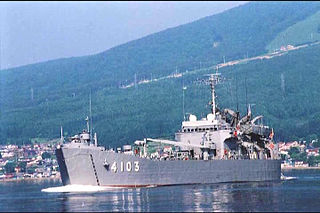
The Atsumi-class landing ship tank is a class of three tank landing ships (LSTs) that served with the Japanese Maritime Self-Defense Force (JMSDF) from 1972 to 2005. They were primarily deployed for logistic support but were also be used to carry heavy construction equipment such as trenchers.
